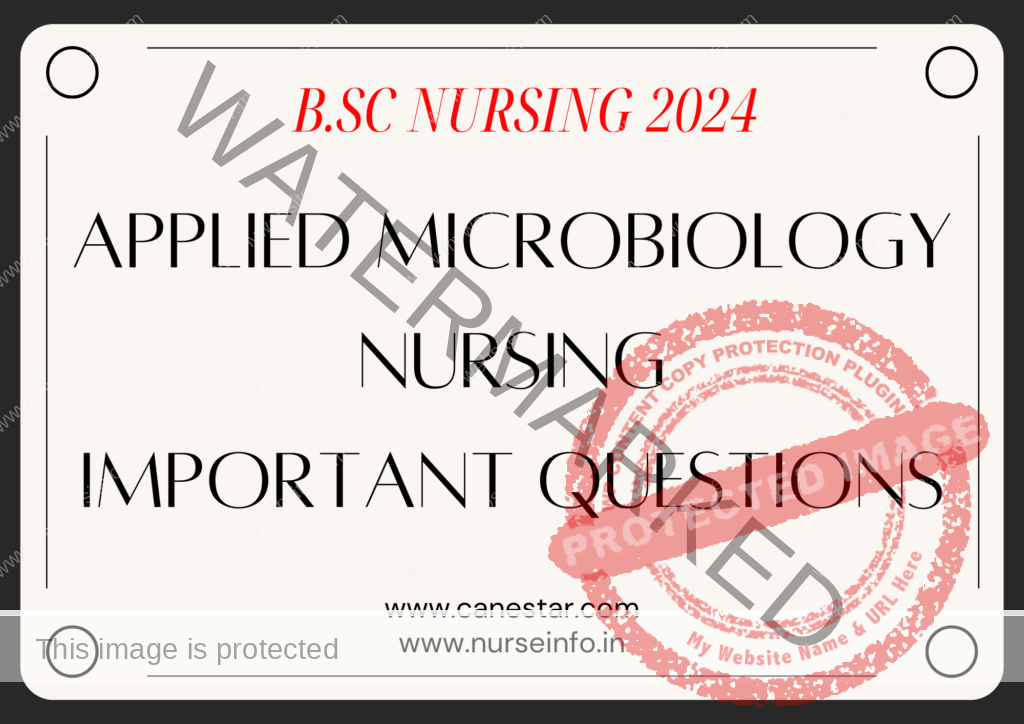APPLIED MICROBIOLOGY
IMPORTANT QUESTIONS
FOR BSC NURSING 2024
FOR FREE APPLIED MICROBIOLOGY SHORT NOTES CLICK HERE
FREE INFECTION CONTROL AND SAFETY NOTES FOR BSC NURSING SECOND YEAR THIRD SEMESTER CLICK HERE
Questions ( 2 Mark)
Structure of Bacteria Diagram
Different shape of Bacteria.
Name four Bacteria.
Name four viruses.
Name Four Fungi.
Name Four Protozoa.
Name Four Helminth.
Name Four Chemical disinfectant.
Name Four Gaseous disinfectant.
Name Four Transport media.
Name Four Anaerobic Media.
MMR
DPT
BCG
Type of Flagella
Louis Pasteur
Robert Koch
Joseph Lister
Edward Jenner
Different type of viruses
Types of Hepatitis Viruses
Screening and Confirmatory test for HIV
Microbiology Questions ( 2 Mark)
Structure of Bacteria Diagram
Different shape of Bacteria.
Name four Bacteria.
Name four viruses.
Name Four Fungi.
Name Four Protozoa.
Name Four Helminth.
Name Four Chemical disinfectant.
Name Four Gaseous disinfectant.
Name Four Transport media.
Name Four Anaerobic Media.
MMR
DPT
BCG
Type of Flagella
Louis Pasteur
Robert Koch
Joseph Lister
Edward Jenner
Different type of viruses
Types of Hepatitis Viruses
Screening and Confirmatory test for HIV
Drugs for HIV Treatment
Name Four DNA viruses
Name Four RNA viruses
Name Four Bacterial diseases
Name Four Viral diseases
Name Four Fungal diseases
Name Four Protozoal diseases
Name Four Helminth diseases
Name Four bacteria causing Food Poisoning
Name Four Bacteria affecting CNS
Name Four Different Worms
Examples for Dermatophytes
Define Sterilization
Steps in Gram Staining
Microbiology Questions ( 5 Mark )
Unit : 1
Robert Koch
Louis Pasteur
Edward Jenner
Koch Postulates.
Unit : 2
Difference between prokaryotes and eukaryotes
Bacterial capsule
Structure of flagella
Transport media
Anaerobic media
Gram stain
Acid fast stain
Bacterial growth curve
Unit : 3
Sources and transmission of infection
Autoclave
Hot air oven
UNIT 4
Mycetoma
Candida albicans
Dermatophytes
Life cycle of plasmodium
Life cycle of entamoeba
Unit : 5
MMR
DPT
BCG
Widal test
ELISA
Microbiology ( 10 Mark )
Unit : 2
Structure of Bacteria
Culture Media
Unit : 3
Sterilization
Hospital or Nosocomial Infection
Biochemical Waster Management
Unit : 4
Staphylococci
Streptococci
Mycobacteria
Neisseria
Vibrio
HIV
Hepatitis
Unit : 5
Types of Immunity
Hypersensitivity
Which of the following microorganisms is responsible for most urinary tract infections (UTIs)? a. Escherichia coli
b. Staphylococcus aureus
c. Streptococcus pneumoniae
d. Mycobacterium tuberculosis
Answer: a. Escherichia coli
A nurse is caring for a patient with a wound infection. The wound appears red, swollen, and warm. This clinical presentation is indicative of: a. Fungal infection
b. Viral infection
c. Bacterial infection
d. Parasitic infection
Answer: c. Bacterial infection
Which of the following is a common method to prevent the spread of hospital-acquired infections? a. Hand hygiene
b. Avoiding vaccinations
c. Overuse of antibiotics
d. Poor waste management
Answer: a. Hand hygiene
A patient is diagnosed with methicillin-resistant Staphylococcus aureus (MRSA) infection. What precautionary measures should the nurse take? a. Standard precautions
b. Contact precautions
c. Droplet precautions
d. Airborne precautions
Answer: b. Contact precautions
Which of the following is an example of an opportunistic fungal infection often seen in immunocompromised patients? a. Candidiasis
b. Tuberculosis
c. Malaria
d. Toxoplasmosis
Answer: a. Candidiasis
What is the primary mode of transmission for Clostridium difficile infection? a. Airborne
b. Droplet
c. Contact
d. Vehicle (fomite)
Answer: c. Contact
Which of the following immunizations is routinely recommended for healthcare workers to prevent hepatitis B virus (HBV) infection? a. Influenza vaccine
b. Hepatitis A vaccine
c. Measles, mumps, and rubella (MMR) vaccine
d. Hepatitis B vaccine
Answer: d. Hepatitis B vaccine
A nurse is caring for a patient with tuberculosis (TB). Which type of isolation precaution is required for this patient? a. Standard precautions
b. Contact precautions
c. Droplet precautions
d. Airborne precautions
Answer: d. Airborne precautions
The process of destroying or inhibiting the growth of microorganisms on inanimate objects is known as: a. Disinfection
b. Sterilization
c. Antisepsis
d. Sanitization
Answer: a. Disinfection
Which of the following is a viral sexually transmitted infection that can lead to cervical cancer? a. Chlamydia
b. Herpes simplex virus (HSV)
c. Human papillomavirus (HPV)
d. Gonorrhea
Answer: c. Human papillomavirus (HPV)
A nurse is caring for a patient with a suspected viral respiratory infection. What precautionary measures should be implemented? a. Standard precautions
b. Contact precautions
c. Droplet precautions
d. Airborne precautions
Answer: c. Droplet precautions
Which of the following is an example of a vector-borne disease transmitted by ticks? a. Dengue fever
b. Lyme disease
c. Chikungunya
d. Zika virus
Answer: b. Lyme disease
What is the primary mode of transmission for the human immunodeficiency virus (HIV)? a. Airborne
b. Fecal-oral
c. Bloodborne
d. Foodborne
Answer: c. Bloodborne
A patient is diagnosed with a respiratory infection caused by the fungus Aspergillus. What type of infection is this likely to be? a. Bacterial infection
b. Viral infection
c. Fungal infection
d. Parasitic infection
Answer: c. Fungal infection
Which of the following is an example of a Gram-negative bacteria that can cause healthcare-associated infections, particularly in immunocompromised patients? a. Staphylococcus aureus
b. Escherichia coli
c. Streptococcus pneumoniae
d. Clostridium difficile
Answer: b. Escherichia coli

